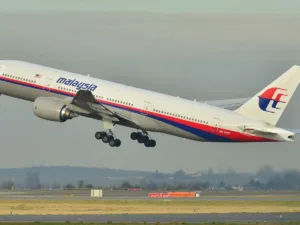Malaysia Flight 370: On March 8, 2014, Malaysia Airlines Flight 370 mysteriously vanished from the radar screens, sparking one of the most perplexing aviation mysteries in history. Despite years of investigation and search efforts, the fate of MH370 and the 239 people on board remains unknown.
Over time, various facts have emerged, shedding light on the intricate details surrounding the disappearance. In this blog, we will delve into 17 untold facts discovered so far, offering a comprehensive perspective on this enigmatic incident.

1. Last Communication:
MH370’s last communication was a routine “Goodnight, Malaysian three-seven-zero” from the cockpit. The abrupt cessation of communication raised initial suspicions, leading investigators to explore possible foul play or technical malfunctions.
2. Satellite Communication:
In the hours following the disappearance, satellite communications revealed that the plane continued to send automated signals. These signals, known as “handshakes,” provided crucial data that became instrumental in narrowing down the search area.
3. Deliberate Actions:
Investigators concluded that the plane’s deviation from its flight path was intentional. The autopilot was reprogrammed, leading the aircraft off course. This discovery fueled speculations about the involvement of someone on board with advanced aviation knowledge.
4. Pilot’s Simulator:
The pilot, Captain Zaharie Ahmad Shah, had a flight simulator at his home. Investigation into the simulator’s data showed that it contained a simulated flight path remarkably similar to MH370’s presumed route. This finding intensified suspicions surrounding the pilot’s role in the incident.

5. Cargo of Lithium Batteries:
MH370 was carrying a significant amount of lithium-ion batteries in its cargo hold. These batteries are known for their flammability and have been implicated in past aviation incidents. The presence of such cargo added complexity to the investigation, raising concerns about a potential fire on board.
6. Inmarsat Data Analysis:
The analysis of Inmarsat satellite data played a pivotal role in refining the search area. By triangulating the satellite signals, investigators were able to establish two possible corridors, one stretching to the southern Indian Ocean. This information guided the subsequent search efforts.
7. Search Challenges:
The search for MH370 proved to be one of the most challenging and expensive in aviation history. The vastness of the southern Indian Ocean and the extreme depths of the seafloor presented formidable obstacles, delaying the discovery of the wreckage.
8. Wing Flap Found on Reunion Island:
In July 2015, a wing flap believed to be from MH370 washed ashore on Reunion Island. This marked the first tangible evidence of the plane’s fate. The discovery raised hopes of finding more debris, providing crucial clues to the final moments of the flight.
9. Ocean Drift Analysis:
Oceanographers conducted drift analysis on debris found along the shores of the western Indian Ocean. This technique helped refine the search area and provided insight into the potential crash site.

10. Possible Wing Debris in Tanzania:
In June 2016, a piece of debris resembling a wing flaperon was discovered on Pemba Island, Tanzania. Although not conclusively linked to MH370, this finding added to the growing body of evidence scattered across the Indian Ocean.
11. Flaperon Damage Analysis:
Experts analyzed the recovered flaperon for clues about the nature of the impact. The extent and nature of damage suggested that the flaperon was likely in a retracted position when it separated from the aircraft, providing insights into the final moments of the flight.
12. Debris in Mozambique:
Additional debris, including a horizontal stabilizer and a piece of a wing, was found along the coasts of Mozambique. These discoveries reinforced the hypothesis that MH370 had indeed crashed in the southern Indian Ocean.
13. French Investigation:
In 2017, the French government took over the investigation, focusing on technical aspects of the flight, including the analysis of recovered debris. The international collaboration aimed to bring fresh perspectives to the ongoing search.
14. Probable Crash Site:
Despite extensive search efforts, the exact location of MH370’s wreckage remained elusive until May 2018 when the Australian Transport Safety Bureau identified a probable crash site within a defined search area.
15. Fuel Endurance:
The investigation revealed that MH370 had more fuel on board than initially estimated, extending the possible distance the aircraft could have traveled. This realization prompted a reevaluation of the search area, taking into account the extended range.

16. No Signs of Distress:
Examination of satellite data and cockpit communications revealed no indications of distress or anomalies leading up to the disappearance. The sudden and deliberate nature of the actions taken by someone on board added an eerie dimension to the mystery.
17. Ongoing Search Efforts:
While the official search for MH370 was suspended in 2017, private companies and organizations continued their efforts to locate the wreckage. Technological advancements and renewed interest in solving the mystery have sparked discussions about the possibility of resuming the search in the future.
Conclusion:
The disappearance of Malaysia Airlines Flight 370 remains a haunting mystery, with each discovery bringing both answers and more questions. The untold facts uncovered so far provide a glimpse into the complexity of the investigation and the collaborative efforts of the international community to unravel the enigma surrounding MH370.
As technology advances and the search for answers continues, the hope remains that one day, the mystery of MH370 will be fully unraveled, bringing closure to the families and friends of the 239 individuals who boarded the ill-fated flight.
WRITTEN BY ALEX
FAQs and answers
1. What happened to Malaysia Airlines Flight 370?
Malaysia Airlines Flight 370 (MH370) vanished on March 8, 2014, while en route from Kuala Lumpur to Beijing. The plane lost contact with air traffic control less than an hour after takeoff, and its final location remains a mystery. Despite extensive search efforts, only a few wreckage pieces have been found on the shores of islands in the Indian Ocean, but the bulk of the wreckage has not been located.
Source: BBC
2. Why is the disappearance of Flight 370 so mysterious?
The mystery surrounding MH370 stems from a lack of clear evidence and unexplained events. The plane’s flight data recorder stopped transmitting data, and the aircraft changed its flight path unexpectedly. The use of radar and satellite tracking data revealed that the plane likely flew for several hours after losing communication, making it challenging to pinpoint its final location.
Source: The Guardian
3. What are some untold facts about Malaysia Airlines Flight 370?
Newly discovered facts include the potential involvement of a rogue pilot or a deliberate diversion, unexplained anomalies in the plane’s communications systems, and the fact that no distress signals were sent. There have also been numerous conspiracy theories regarding the involvement of governments and agencies, though none have been proven.
Source: CNN
4. Has any wreckage of MH370 been found?
Yes, some wreckage, including a wing flaperon, was found washed ashore on the islands of the Indian Ocean, most notably on Réunion Island in 2015. However, the majority of the plane’s wreckage remains missing, despite ongoing search efforts.
Source: ABC News
5. Is there any hope of ever finding MH370?
While the chances of finding the main wreckage are diminishing, there is always a possibility due to ongoing technological advancements in search methods. The search was officially suspended in 2018, but there are still private organizations and individuals who hope to continue the search.
Source: The Independent
6. What does the investigation into MH370 reveal about aviation safety?
The investigation into MH370 has highlighted potential weaknesses in aviation safety, such as the need for better tracking systems, more transparent communication between airlines and authorities, and improved flight data monitoring.
Source: The Aviation Herald
7. What are the latest theories about the disappearance of MH370?
Some theories suggest the plane was intentionally diverted by the pilot or someone on board, while others believe there was a mechanical failure that caused the plane to crash. The lack of concrete evidence has made it difficult to definitively confirm any of these theories.
Source: National Geographic

